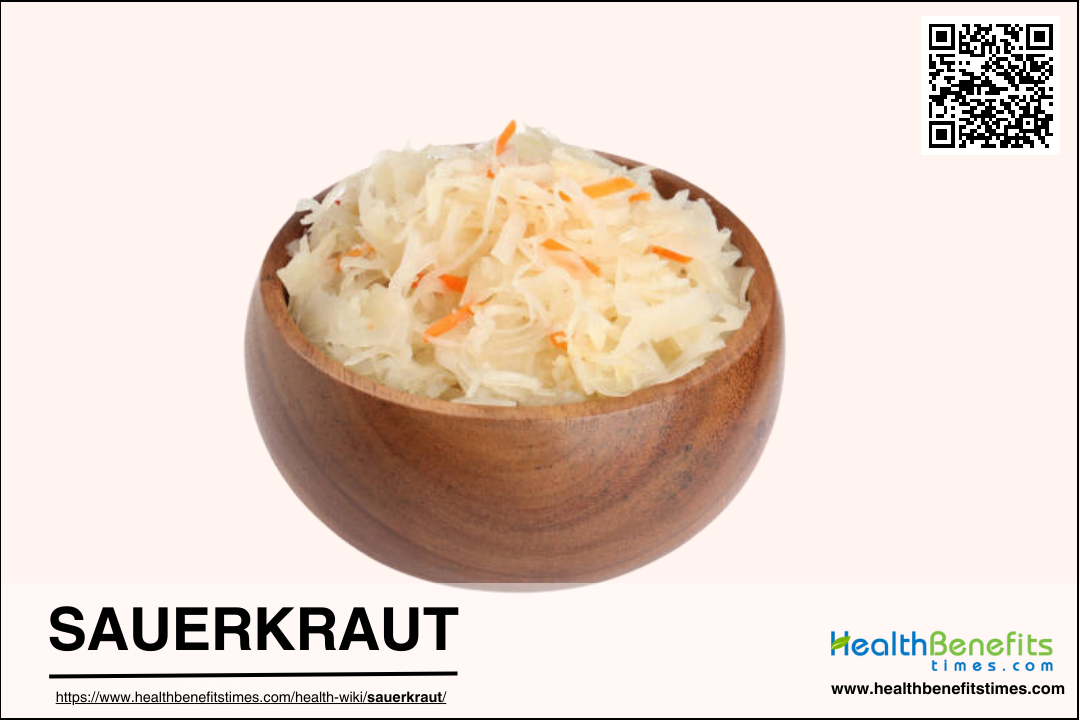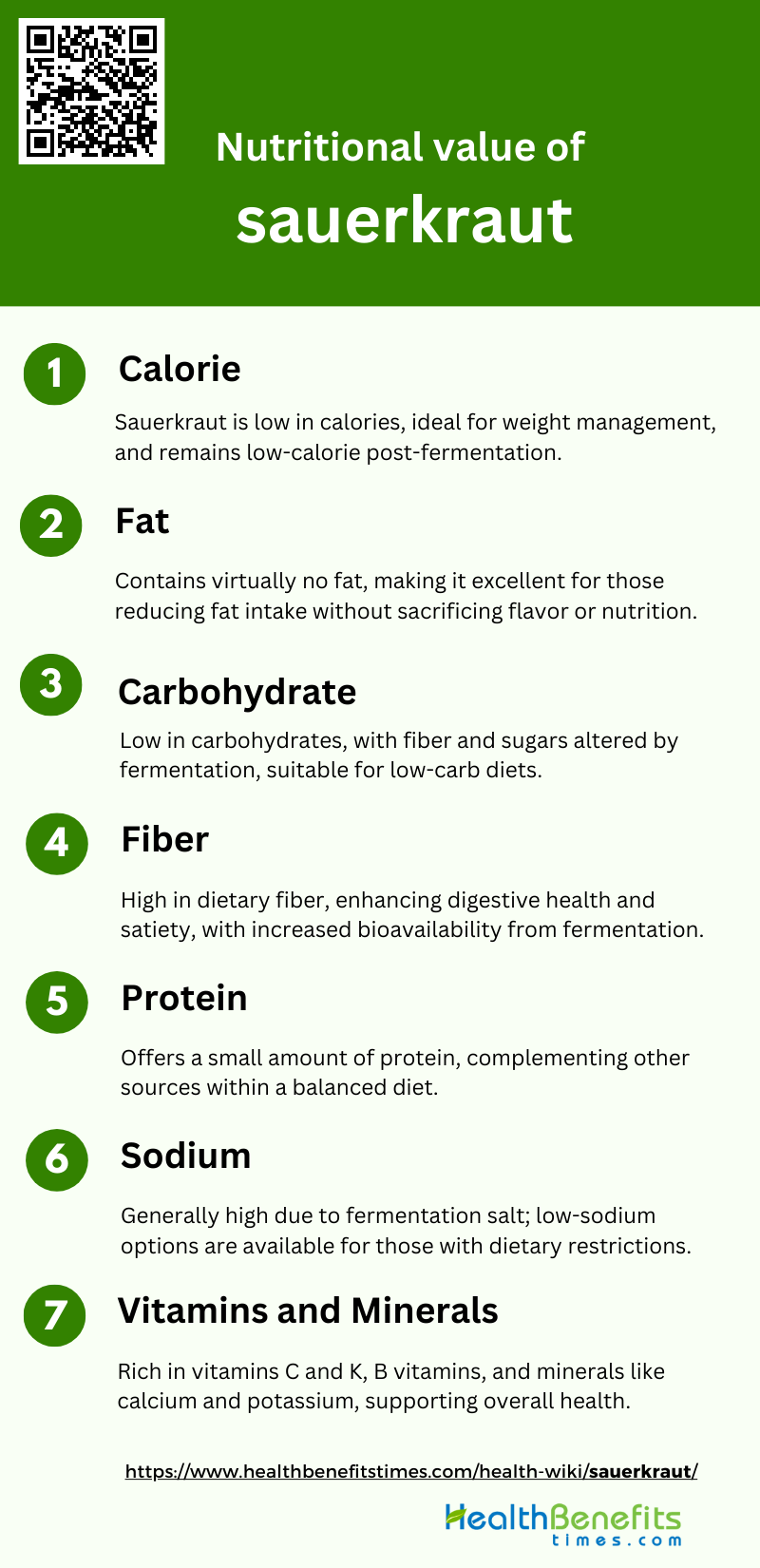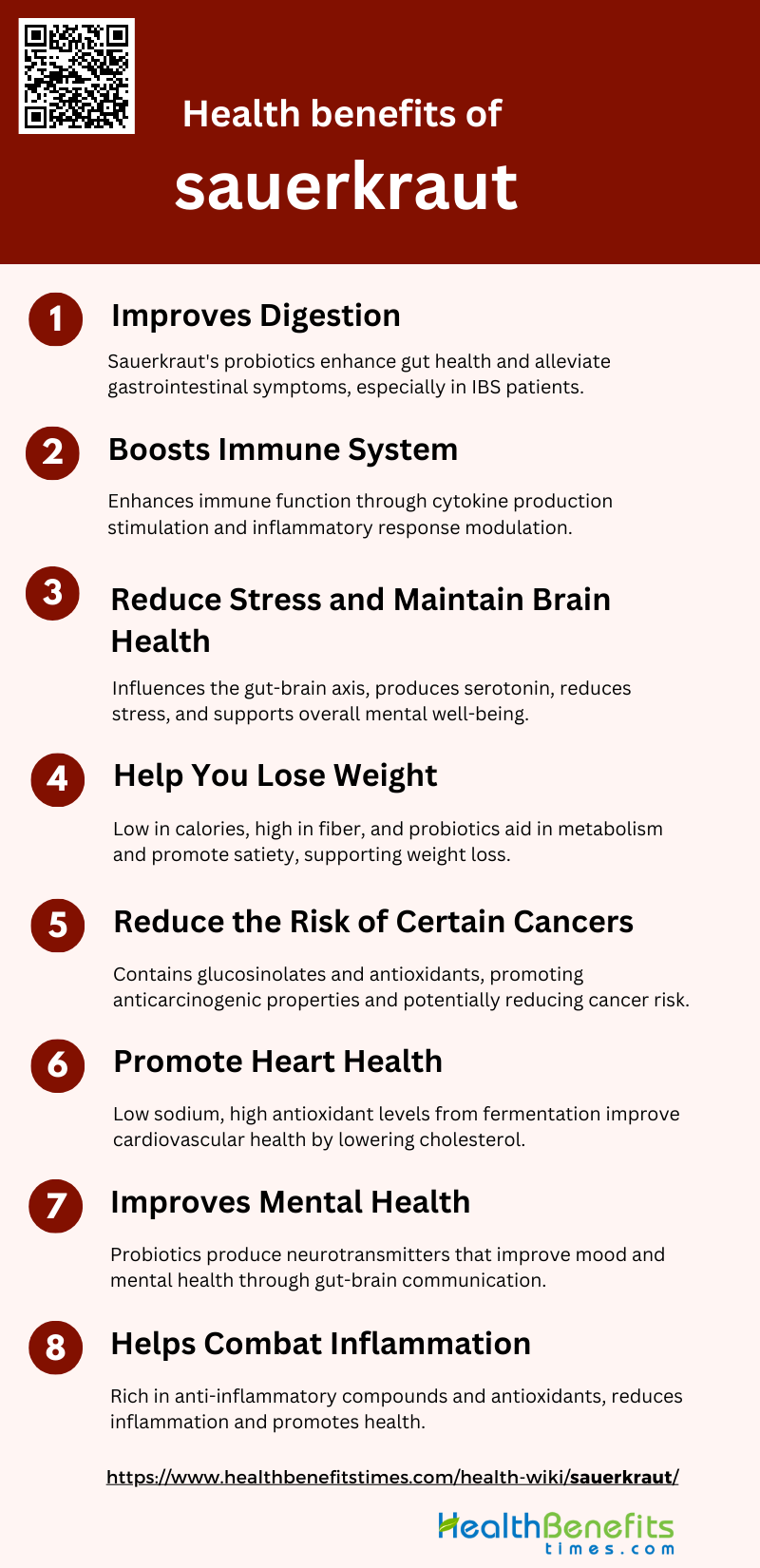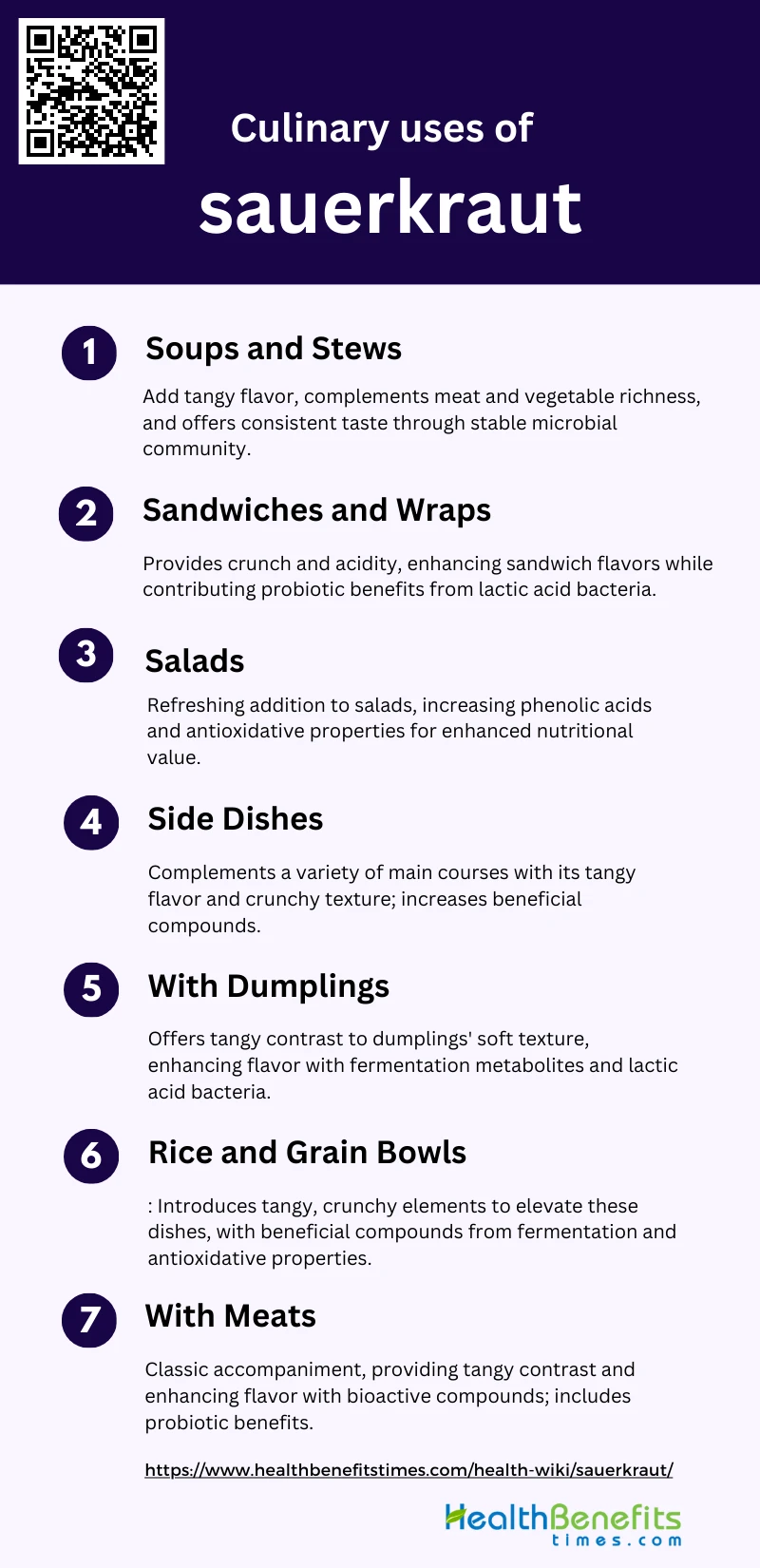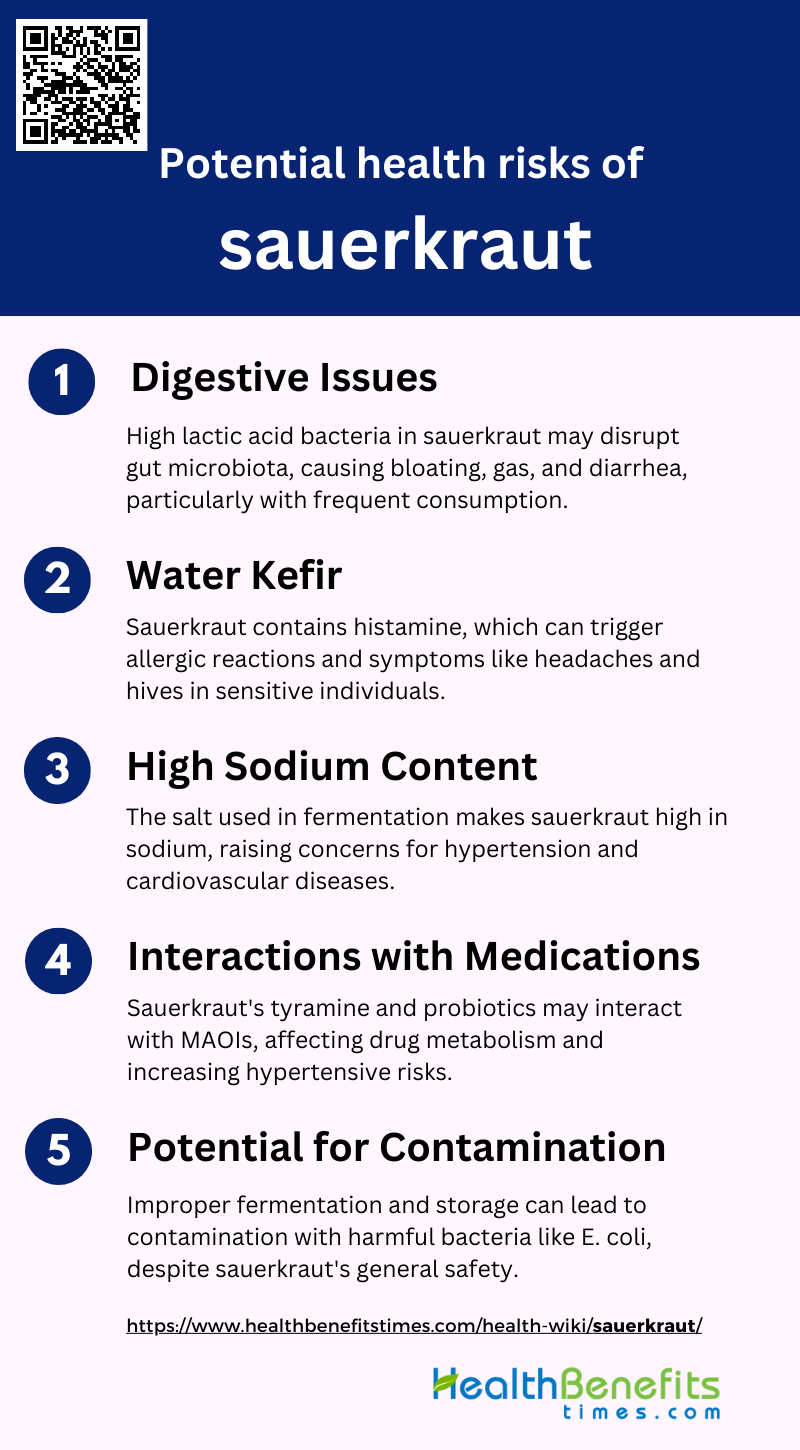Sauerkraut is a fermented cabbage dish that originated in Germany. It is made by finely shredding green cabbage and then fermenting it with lactic acid bacteria under anaerobic conditions. The fermentation process gives sauerkraut its distinctive sour flavor and allows it to keep for several months. Sauerkraut is a staple side dish in German cuisine, often served alongside pork dishes, sausages, and potatoes. It is also popular in other Central and Eastern European countries. Beyond its culinary uses, sauerkraut is a good source of vitamins C, B, and K, as well as dietary fiber and probiotics from the lactic acid bacteria.
Nutritional value of Sauerkraut
It is rich in essential nutrients and probiotics that support gut health and boost the immune system. Below are some key nutritional components found in sauerkraut:
1. Calorie
Sauerkraut is a low-calorie food, making it an excellent choice for those looking to manage their weight. According to research, sauerkraut contains very few calories due to its primary ingredient, cabbage, which is naturally low in calories. This makes it a suitable addition to a calorie-conscious diet without compromising on nutritional value. The fermentation process does not significantly increase the caloric content, ensuring that sauerkraut remains a low-calorie option even after processing.
2. Fat
The fermentation process primarily involves lactic acid bacteria and does not introduce any significant amount of fat into the product. This characteristic makes sauerkraut an ideal food for individuals seeking to reduce their fat consumption while still enjoying a flavorful and nutritious food option.
3. Carbohydrate
The carbohydrate content in sauerkraut is relatively low, primarily consisting of dietary fiber and simple sugars that are partially broken down during fermentation. The fermentation process by lactic acid bacteria converts some of the sugars in cabbage into lactic acid, which reduces the overall carbohydrate content. This makes sauerkraut a suitable food for those managing their carbohydrate intake, such as individuals with diabetes or those following a low-carb diet.
4. Fiber
Sauerkraut is rich in dietary fiber, which is essential for digestive health. The fiber content in sauerkraut helps promote regular bowel movements and can aid in preventing constipation. Additionally, the fermentation process enhances the bioavailability of fiber, making it more effective in supporting gut health. The high fiber content also contributes to a feeling of fullness, which can help with weight management.
5. Protein
Sauerkraut contains a small amount of protein, primarily derived from the cabbage used in its production. While not a significant source of protein, the presence of amino acids from the fermentation process can contribute to the overall protein intake. The protein content in sauerkraut is not substantial enough to meet daily protein requirements but can complement other protein sources in a balanced diet.
6. Sodium
The sodium content can vary depending on the amount of salt used, but it is generally high, which can be a concern for individuals with hypertension or those monitoring their sodium intake2. However, low-sodium versions of sauerkraut are available and can provide the same nutritional benefits with reduced sodium levels.
7. Vitamins and Minerals
Sauerkraut is a rich source of vitamins and minerals, particularly vitamin C, vitamin K, and various B vitamins. The fermentation process helps preserve these vitamins, making sauerkraut a valuable addition to the diet for boosting immune function and overall health. Additionally, sauerkraut contains essential minerals such as calcium, potassium, and iron, which contribute to bone health, electrolyte balance, and oxygen transport in the body. The presence of these nutrients makes sauerkraut a nutrient-dense food with multiple health benefits.
Health Benefits of Sauerkraut
Rich in probiotics, vitamins, and minerals, it supports digestive health, boosts the immune system, and may even contribute to heart health. Below are some of the key health benefits of incorporating sauerkraut into your diet:
1. Improves Digestion
The fermentation process enhances the probiotic content of sauerkraut, which can help balance the gut microbiota. Studies have shown that consuming sauerkraut can lead to significant improvements in gastrointestinal symptoms, particularly in patients with irritable bowel syndrome (IBS). The presence of LAB such as Lactobacillus plantarum and Lactobacillus brevis in sauerkraut contributes to these beneficial effects by promoting a healthy gut environment.
2. Boosts Immune System
The probiotics found in sauerkraut not only aid digestion but also enhance the immune system. LAB like Lactiplantibacillus plantarum have been shown to stimulate the production of cytokines, which are crucial for immune response. Additionally, sauerkraut brine has been found to modulate inflammatory responses, suggesting that it can help regulate intestinal immune function. Regular consumption of sauerkraut can thus support a robust immune system by promoting the growth of beneficial gut bacteria and enhancing immune responses.
3. Help You Lose Weight
The high fiber content helps in promoting satiety, reducing overall calorie intake. Moreover, the probiotics in sauerkraut can improve gut health, which is linked to better metabolism and weight management. The fermentation process also increases the bioavailability of nutrients, making sauerkraut a nutrient-dense food that supports weight loss efforts.
4. Reduce Stress and Maintain Brain Health
The gut-brain axis is a well-established concept, and the probiotics in sauerkraut can positively influence mental health. LAB such as Lactobacillus plantarum has been shown to produce neurotransmitters like serotonin, which can help reduce stress and improve mood. Additionally, the anti-inflammatory properties of sauerkraut can help mitigate stress-related inflammation, further supporting brain health. Regular consumption of sauerkraut can thus contribute to better mental well-being by promoting a healthy gut-brain connection.
5. Reduce the Risk of Certain Cancers
Sauerkraut contains bioactive compounds such as glucosinolates, which have been shown to have anticarcinogenic properties. The fermentation process enhances the formation of these compounds, making sauerkraut a potent food for cancer prevention. Studies have indicated that sauerkraut juice can induce apoptosis in gastric adenocarcinoma cells, suggesting its potential in reducing the risk of certain cancers. The presence of antioxidants and anti-inflammatory compounds in sauerkraut further supports its role in cancer prevention.
6. Promote Heart Health
The low sodium content and high levels of beneficial compounds in sauerkraut make it a heart-healthy food. Fermentation with LAB such as Leuconostoc mesenteroides at low salt concentrations has been shown to produce sauerkraut with high levels of antioxidants and low sodium, which are beneficial for cardiovascular health. Additionally, the probiotics in sauerkraut can help lower cholesterol levels, further promoting heart health. Regular consumption of sauerkraut can thus support cardiovascular well-being by providing essential nutrients and beneficial bacteria.
7. Improves Mental Health
The probiotics in sauerkraut can have a significant impact on mental health by influencing the gut-brain axis. LAB such as Lactiplantibacillus plantarum has been shown to produce neurotransmitters that can improve mood and reduce anxiety. The anti-inflammatory properties of sauerkraut also play a role in reducing stress-related inflammation, which can positively affect mental health. Consuming sauerkraut regularly can thus contribute to better mental health by promoting a healthy gut environment and reducing inflammation.
8. Helps Combat Inflammation
Sauerkraut is rich in antioxidants and anti-inflammatory compounds, which can help combat inflammation. The fermentation process enhances the production of these compounds, making sauerkraut a potent anti-inflammatory food. Studies have shown that sauerkraut brine can modulate inflammatory responses, suggesting its potential in reducing inflammation. The presence of selenium in sauerkraut also contributes to its anti-inflammatory properties, further supporting its role in combating inflammation. Regular consumption of sauerkraut can thus help reduce inflammation and promote overall health.
Culinary Uses of Sauerkraut
It can be used in a variety of dishes, adding a unique taste and texture. Here are some popular culinary uses of sauerkraut:
1. Soups and Stews
The lactic acid bacteria (LAB) present in sauerkraut contribute to its distinctive sourness, which can complement the richness of meats and vegetables in these dishes. Additionally, the fermentation process of sauerkraut produces various bioactive compounds, such as ascorbigen and indole-3-carbinol, which may offer health benefits when consumed. The stability of the microbial community in sauerkraut ensures that its flavor remains consistent throughout the cooking process, making it a reliable ingredient for soups and stews.
2. Sandwiches and Wraps
Incorporating sauerkraut into sandwiches and wraps can provide a delightful crunch and a burst of acidity that balances the flavors of other ingredients. The sensory qualities of sauerkraut, influenced by its chemical composition and the variety of cabbage used, make it a versatile addition to various types of sandwiches and wraps. The presence of LAB such as Lactobacillus plantarum and Leuconostoc mesenteroides in sauerkraut not only enhances its taste but also contributes to its potential probiotic benefits, making it a nutritious choice for these quick meals.
3. Salads
Sauerkraut can be a refreshing and tangy addition to salads, adding both texture and flavor. The fermentation process increases the levels of free phenolic acids and other bioactive compounds in sauerkraut, which can contribute to the overall nutritional value of salads. The dynamic changes in the lactic acid bacteria flora during fermentation ensure that sauerkraut maintains its crispness and flavor, making it an excellent ingredient for a variety of salad recipes. Additionally, the antioxidative properties of exopolysaccharides from LAB in sauerkraut can enhance the health benefits of salads.
4. Side Dishes
As a side dish, sauerkraut can complement a wide range of main courses, from meats to vegetarian dishes. Its tangy flavor and crunchy texture can provide a pleasant contrast to richer, heavier foods. The fermentation process not only enhances the taste of sauerkraut but also increases its content of beneficial compounds such as polyphenols and flavonoids, which can contribute to overall health. The stable microbial community in sauerkraut ensures that it retains its quality and flavor, making it a reliable side dish option.
5. With Dumplings
Sauerkraut pairs exceptionally well with dumplings, offering a tangy contrast to the soft, starchy texture of the dumplings. The fermentation process of sauerkraut produces various flavor metabolites, including esters, aldehydes, and ketones, which can enhance the overall taste experience when combined with dumplings. The presence of LAB such as Lactobacillus plantarum and Leuconostoc mesenteroides in sauerkraut contributes to its unique flavor profile, making it a perfect accompaniment to dumplings 10.
6. Rice and Grain Bowls
Adding sauerkraut to rice and grain bowls can introduce a tangy and crunchy element that elevates the dish. The fermentation process of sauerkraut results in the formation of bioactive compounds and flavor metabolites that can enhance the overall taste and nutritional value of rice and grain bowls. The stable and rapidly established microbial community in sauerkraut ensures that it maintains its quality and flavor, making it a versatile ingredient for these types of meals. Additionally, the antioxidative properties of exopolysaccharides from LAB in sauerkraut can contribute to the health benefits of rice and grain bowls.
7. With Meats
The fermentation process of sauerkraut produces various bioactive compounds and flavor metabolites that can complement the richness of meats. The presence of LAB such as Lactobacillus plantarum and Leuconostoc mesenteroides in sauerkraut not only enhances its taste but also contributes to its potential probiotic benefits, making it a nutritious addition to meat dishes. The stable microbial community in sauerkraut ensures that it retains its quality and flavor, making it a reliable choice for pairing with meats.
How to Make Sauerkraut at Home
Making sauerkraut at home is a simple and rewarding process that requires just a few ingredients and some patience. This guide will walk you through each step to create your own delicious, tangy sauerkraut. Here’s how to do it:
1. Prepare the Cabbage: Remove the outer leaves of the cabbage and set them aside. Cut the cabbage into quarters and remove the core. Slice the cabbage thinly using a knife or mandoline slicer.
2. Salt the Cabbage: Place the sliced cabbage in a large mixing bowl. Sprinkle the sea salt over the cabbage. Massage the cabbage with your hands for about 5-10 minutes until it starts to release its juices and becomes limp.
3. Pack the Cabbage: Transfer the cabbage and its juices into a clean glass jar or fermentation crock. Pack it down tightly to remove any air pockets. Use a tamper or the back of a spoon to press it down. Place the reserved outer leaves on top of the packed cabbage to help keep it submerged.
4. Weigh Down the Cabbage: Place a weight on top of the cabbage to keep it submerged under its juices. A smaller jar filled with water can serve as a weight. Cover the jar with a cloth or a loose-fitting lid to allow gases to escape during fermentation.
5. Ferment: Store the jar at room temperature, away from direct sunlight. Check the sauerkraut daily to ensure the cabbage remains submerged. Press it down if necessary. Fermentation time can vary, but it usually takes about 1-4 weeks. Taste the sauerkraut after one week and continue fermenting until it reaches your desired flavor and texture.
6. Store: Once the sauerkraut is ready, transfer it to the refrigerator to slow down the fermentation process. It can be stored in the refrigerator for several months.
Potential Health Risks of Sauerkraut
While sauerkraut is known for its health benefits, it is important to be aware of some potential health risks associated with its consumption. These risks can vary depending on individual health conditions and the amount consumed. Here are some potential health risks of sauerkraut:
1. Digestive Issues
While sauerkraut is often praised for its probiotic benefits, it can also cause digestive issues in some individuals. The high levels of lactic acid bacteria (LAB) present in sauerkraut can lead to an imbalance in gut microbiota, potentially causing symptoms such as bloating, gas, and diarrhea. Studies have shown that repeated intake of sauerkraut may induce local inflammation and result in diarrhea. Additionally, the fermentation process can produce various metabolites that might not be well-tolerated by everyone, further contributing to digestive discomfort.
2. Histamine Sensitivity
Sauerkraut contains histamine, a compound that can trigger allergic reactions and other symptoms in sensitive individuals. A survey of sauerkraut samples revealed an average histamine content of 5.06 mg/100g, with some samples containing up to 13.0 mg/100g. Although these levels are lower than those associated with food poisoning, they can still cause issues for people with histamine intolerance, leading to symptoms such as headaches, hives, and digestive problems.
3. High Sodium Content
The sodium content in sauerkraut can be a concern, especially for individuals with hypertension or cardiovascular diseases. The fermentation process often involves adding salt to inhibit the growth of undesirable bacteria and to enhance the flavor. Studies have shown that sauerkraut can have varying sodium levels depending on the fermentation conditions, with some products containing high amounts of salt. High sodium intake is linked to increased blood pressure and a higher risk of heart disease, making it important for consumers to monitor their sauerkraut consumption.
4. Interactions with Medications
The presence of tyramines in sauerkraut can lead to hypertensive crises when consumed with MAOIs. Additionally, the high levels of probiotics and other bioactive compounds in sauerkraut may affect the metabolism and efficacy of various drugs, necessitating caution and consultation with healthcare providers for individuals on medication.
5. Potential for Contamination
Although sauerkraut is generally considered safe, there is a potential risk for contamination with harmful bacteria such as Escherichia coli (E. coli) if proper fermentation and storage practices are not followed. Studies have shown that the salt concentration and fermentation conditions significantly affect the microbial load in sauerkraut, with inadequate salt levels potentially allowing the growth of pathogenic bacteria. Ensuring proper hygiene and fermentation practices can mitigate these risks, but consumers should still be aware of the potential for contamination.


